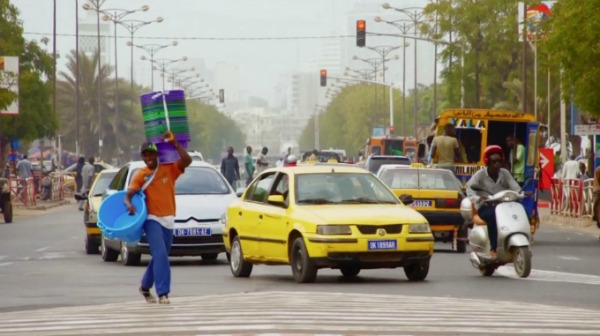The market is very likely to be one of the first places that encounter when you travel. You need to buy food, shoes, exchange money, get directions to your next destination or linger in the energy of wherever you have just arrived. Dakar’s Colobane market in Senegal is no different. It refuses, however, to provide the travelling onlooker with a comprehensive Sengalase ‘whole’ in which to feel rooted and fully arrived. This is a space that doesn’t allow the “typical” or the “authentic” to ossify, throbbing instead in a flux of innovation and transformation in which geographical and identity borders are constantly deferred and under renegotiation. It is, as described by many of the documentary’s interviewees, a beehive.
Situated next to the Gare Routière, the train station, and the motorway, Colobane is a nexus of paths and crossings that turns a place of passing and va-et-vient into a destination in itself. To “arrive” here is to enter into a moot position of exchange, to never exactly know where you are. The market lays network upon network, the physical footpaths between stalls intersecting with unspoken networks of private and public spaces, private and public relationships, overlaid upon each other. Wide shots of the market show the stalls to merge with private properties, flats and apartments. Interviewees talk of “renting space” and “buying space”, with notions of property, privacy and permanence emerging to be intricately polysemantic. Women are seen doing their laundry in an open space of the market, similarly negotiating the domestic and the communal. An artist interviewed in the documentary about his passion of making sculptures out of used and broken things he finds in the market sees “bien-être”, well-being, as a direct effect of the lived logic of creativity and inspiration present in Colobane. This is an African renaissance in process, he says.
One of the documentary’s main strengths is its ardent sense of humour. One frequenter of Colobane talks about renting shoes from the market in order to impress women for a night out. If he hadn’t returned the shoes by 6am the following morning, he goes on to tell, he will have to pay extra to keep them for longer and it will be known that he has been successful. Another great moment occurs with the artist fixing the head of a Western doll onto a structure of colourful blocks, the battered and smudged plastic of the face still showcasing a hilariously coy experience. This humour is surely part of the well-being he describes and is sparked by eclectic mixes and unexpected assemblages; there is a tangible irony and laughter to the market that holds its energy in the balance. Prices are fluid, depending on the time of the day, the customer, the object, “the emotion” of the encounter with the customer, yet are seen to equal out and to sustain this balance as much as they sustain the thrill of the unpredictable and the energy of the exchange.
Strikingly, this energy cannot be fully translated into the documentary’s visual style: this, the documentary appears to accept and even enjoy. Whilst the many different interviews colour stories and accounts of the market, only rarely do we see exchange in action, or even the faces of customers and vendors. To attempt to capture the market in full movement, it is felt, would be to artificially frame and delineate an encounter, to focus on the trees rather than the wood, or to make silhouetted an object out of that which is vitally a linkage or an in-between. This tension between art and functionality, between movement and its capture, is interestingly but not exhaustively pursued in the interviews with the many artists featured in the documentary. Before a backdrop of debates regarding the appropriation of African artefacts as objects of “art” in Western museums and galleries, questions are left open as to how exactly these Senegalese artists operate within the economy of the market, and whether their creations fetishize objects of function and lived life, or participate in the wider designs and waves of Colobane. The market’s most striking power, it would seem, is to keep these questions in constant deferral and circulation.
As Christmas approaches, conversation again arises about the way we buy things in the UK, about how we interact with our infrastructures and, most pressingly, about whether or not we are at all excited about any of this. An interrogation into the sterility and unproductive monotony of our own shopping systems is one of this documentary’s most welcome gifts.
httpvh://youtu.be/eaUnSdTmao0


